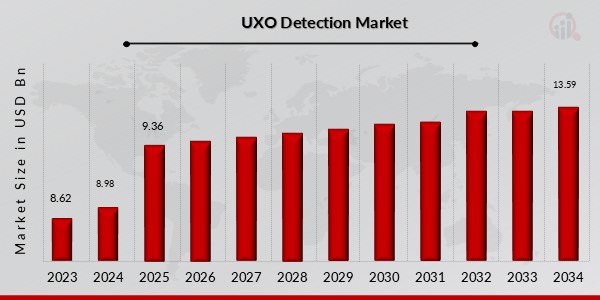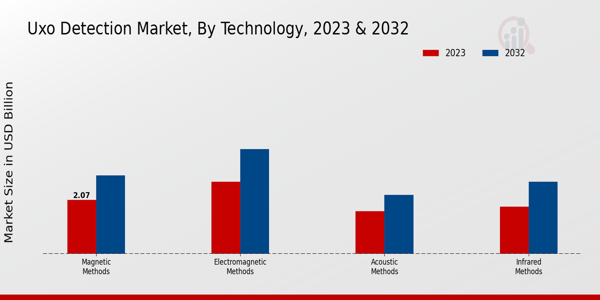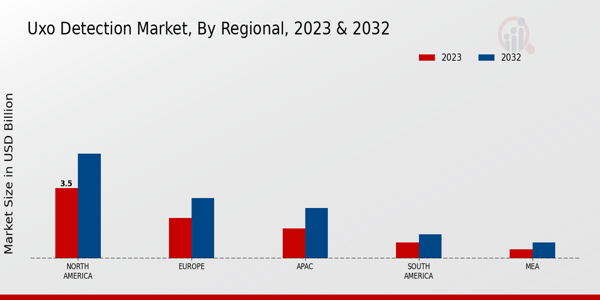UXO Detection Market Overview
The UXO detection market size was estimated at 8.98 (USD billion) in 2024. The UXO detection market is expected to grow from 9.36 (USD billion) in 2025 to 13.59 (USD billion) by 2034. The UXO detection market CAGR (growth rate) is expected to be around 4.20% during the forecast period (2025 - 2034).
 4
Source: Primary Research, Secondary Research, Market Research Future Database and Analyst Review
4
Source: Primary Research, Secondary Research, Market Research Future Database and Analyst Review
Key UXO Detection Market Trends Highlighted
The UXO Detection Market is significantly influenced by a range of key market drivers, with increasing awareness of public safety being paramount. Many countries are recognizing the hazards posed by unexploded ordnance left from past military conflicts, driving investments in detection technologies.
Additionally, government initiatives to clear land for development projects and agricultural use promote demand for efficient UXO detection solutions. Technological advancements in detection methods and the growing adoption of drones and robotics are further accelerating market growth.
Opportunities within the UXO detection market are abundant, particularly for companies focusing on innovative detection technologies and collaborative approaches. There is a growing need for partnerships between defense organizations and technology providers to enhance detection capabilities.
Emerging markets, especially in regions prone to conflicts, present a fertile ground for expansion. The shift toward more environmentally friendly approaches to UXO removal and detection also opens avenues for companies to develop sustainable solutions, thus appealing to eco-conscious stakeholders.
In recent times, the trend toward automation in UXO detection has gained traction. This has led to the development of sophisticated algorithms and software that improve the accuracy and efficiency of detection processes.
Furthermore, there is a noticeable increase in investment aimed at research and development within the industry. This trend signals a commitment to advancing UXO detection technologies while addressing historical land contamination issues.
The integration of artificial intelligence and machine learning into detection systems is becoming more common as stakeholders seek to optimize operations and ensure safer environments for communities affected by unexploded ordnance.
UXO Detection Market Drivers
Increasing Awareness about Land Safety and Security
The growing awareness regarding land safety and security is significantly driving the UXO Detection Market. With numerous regions still grappling with the aftermath of past conflicts, there are extensive concerns about unexploded ordnance (UXO) remaining buried in the ground.
This heightened awareness has led to increased demand for effective UXO detection technologies. Governments, international organizations, and NGOs are increasingly investing in programs aimed at identifying and clearing these hazards to ensure public safety and facilitate land use for agriculture, construction, and development.
Moreover, the global population's concern over environmental safety, land reuse, and sustainable development is propelling the growth of this market.
As countries advance into modernization, old war zones being turned into urban areas necessitate clearing operations to remove UXOs, thereby reinforcing the need for advanced detection technologies. Additionally, the market benefits from improved training and awareness campaigns regarding UXO dangers, which further bolster demand for detection services.
This ongoing commitment to safety and remediation projects reflects the critical role that the UXO detection industry plays in ensuring that communities do not face the hazards of unexploded munitions, driving robust growth prospects for the UXO Detection Market in the coming years.
Technological Advancements in Detection Equipment
The sector is witnessing a wave of technological advancements that are enhancing the efficiency and accuracy of UXO detection techniques. Innovations in sensor technologies, data integration, and mobile applications have revolutionized the way UXOs are located and dealt with.
The development of multi-sensor systems that can detect various types of ordnances simultaneously and utilize artificial intelligence to analyze data advanced the capabilities of detection teams.
The integration of drones and automated machines in surveying and mapping sites has also contributed significantly to this growth. As these sophisticated technologies emerge and gain acceptance in the market, they lead to improved operational efficiencies and cost-effectiveness, further driving the UXO Detection Market forward.
Government Policies and Funding for Remediation Projects
Government initiatives aimed at supporting remediation and clearance projects constitute a fundamental driver of the UXO Detection Market. Increased funding allocated for safety-related programs and international collaboration on clearance operations demonstrate a commitment from authorities to address UXO challenges.
Various countries, particularly those with historical battlefields or military installations, are enacting policies that prioritize the identification and elimination of UXOs to ensure the safety of citizens.
As public awareness and potential risks associated with unexploded ordnance rises, governments are likely to allocate more resources to productively deal with these threats. Public-private partnerships and collaboration with non-governmental organizations to pool resources for cleanup efforts are also amplifying market growth.
Furthermore, favorable regulations and frameworks for private contractors engaged in UXO detection and clearance are paving the way for future growth in the market.
UXO Detection Market Segment Insights
UXO Detection Market Technology Insights
The UXO Detection Market is expected to exhibit significant revenue growth within the technology segment. The technology segment includes a variety of approaches, namely magnetic methods, electromagnetic methods, acoustic methods, and infrared methods, each contributing uniquely to the overall market growth.
Among these, magnetic methods held a significant position, valued at 2.07 USD billion in 2023 and anticipated to rise to 3.0 USD billion by 2032. This method is vital in the detection of ferromagnetic objects and is widely used due to its effectiveness in identifying unexploded ordnance in various terrains.
Following closely was the electromagnetic multi-sensor systems methods sector, valued at 2.75 USD billion in 2023 and expected to grow to 4.0 USD billion by 2032. This method is significant for its ability to detect non-ferrous items, making it essential in regions where traditional methods may fall short.
Acoustic methods, while smaller in market valuation at 1.63 USD billion in 2023, projected to reach 2.25 USD billion by 2032, provided essential capabilities in underwater UXO detection and is increasingly gaining attention for its effectiveness in submerged environments.
Lastly, infrared methods, valued at 1.81 USD billion in 2023 with a projected increase to 2.75 USD billion by 2032, were crucial for detecting munitions not easily identified by magnetic or electromagnetic means, particularly in environments where visual inspections are challenging.
The distinctions across these methods highlight their specialized applications, illustrating a diversified strategy in UXO detection. As the market evolves, technological innovations and increased investment in safer detonation methods are likely to drive growth across all segments, catering to the rising demand for enhanced safety and efficient detection solutions.
The relevance of each method in distinct environments underlines the necessity for a multifaceted approach in the UXO Detection Market, ensuring its resilience against challenges posed by varying ground conditions and technological limitations.

Source: Primary Research, Secondary Research, Market Research Future Database and Analyst Review
UXO Detection Market End Use Insights
The military segment plays a crucial role due to the ongoing need for safety in defense operations, while civilian engineering is increasingly important for infrastructure development in areas previously affected by conflicts.
Environmental remediation is gaining traction as concerns for ecological restoration grow, highlighting the necessity for UXO detection in contaminated sites. In construction, regulatory compliance and safety standards necessitate thorough UXO surveys, making this segment significant for project procurement.
Overall, the market segmentation reveals a clear alignment with global needs for security, environmental protection, and infrastructure integrity, showcasing trends driven by advancements in detection technologies and increasing insights into unexploded ordnance management.
The growth drivers, including heightened governmental regulations and funding for explosive ordnance disposal, present substantial opportunities, although challenges such as budget constraints and technological limitations remain prevalent.
The UXO Detection Market statistics underline its critical nature across these key segments, fostering continuous investment in research and development to address evolving challenges.
UXO Detection Market Component Insights
Within this market, components such as sensors and detection systems significantly contribute, providing essential tools for locating unexploded ordnance efficiently.
Sensors are vital in recognizing buried threats, while detection systems integrate various technologies for accurate mapping and identification. Software solutions enhance operational capabilities by offering advanced data analysis and user-friendly interfaces, promoting effective decision-making in critical situations.
Accessories, although often overlooked, provide necessary support to these primary components, ensuring their optimal functionality. This combination of components underscores the importance of technology in improving safety measures and driving market growth.
Additionally, trends such as rising defense spending and increasing investment in infrastructure development further contribute to the UXO Detection Market statistics, indicating robust demand for enhanced detection capabilities and, ultimately, aiding in reducing risk to civilian populations.
UXO Detection Market Application Insights
The UXO Detection Market application segment plays a crucial role in ensuring safety and security in areas affected by unexploded ordnance.
Within this segment, the demand for landmine detection remains significant, driven by increasing global awareness of the humanitarian impact of landmines. Bomb disposal operations also dominate the market, emphasizing the importance of timely and safe neutralization of explosive threats.
Furthermore, site remediation is gaining traction as governments and organizations strive to restore contaminated areas for safe use, further promoting market growth. Search and recovery activities are equally vital, especially in post-conflict zones, ensuring that communities can return to normalcy safely.
The UXO Detection Market revenue is reflective of the industry's response to rising safety standards, with a focus on innovative detection technologies. Overall, the UXO Detection Market statistics illustrate a steady rise in demand across these applications, underscoring both opportunities and challenges in enhancing safety measures worldwide.
UXO Detection Market Regional Insights
The UXO Detection Market exhibits a diverse regional landscape, with North America leading the charge, valued at 3.5 USD billion in 2023 and projected to reach 5.2 USD billion by 2032, indicating its dominant position in the market due to technological advancements and significant military operations.
Europe followed as a substantial contributor, with a valuation of 2.0 USD billion in 2023 and an expected rise to 3.0 USD billion by 2032, reflecting ongoing safety and reclamation efforts in post-conflict zones. The APAC region, despite its smaller share at 1.5 USD billion in 2023, showed promise with a projected growth to 2.5 USD billion by 2032, driven by increasing investments in mine clearance activities.
In South America, the market valuation started at 0.8 USD billion in 2023, reaching 1.2 USD billion by 2032, largely fueled by humanitarian efforts and environmental concerns. Meanwhile, the MEA region, although the least valued at 0.46 USD billion in 2023, is anticipated to grow to 0.8 USD billion by 2032, signifying a rising awareness of UXO challenges in conflict-affected areas.
The overall UXO Detection Market revenue is influenced by the unique needs and developments within each of these regions, showcasing a blend of growth, opportunity, and challenges that collectively shape the trends within the industry.
Source: Primary Research, Secondary Research, Market Research Future Database and Analyst Review
UXO Detection Market Key Players and Competitive Insights
The UXO Detection Market is characterized by a rapidly evolving landscape driven by advancements in technology and an increasing emphasis on safety and environmental preservation. Unexploded ordnance (UXO) presents a significant threat in post-conflict areas, leading to heightened demand for effective detection and remediation solutions.
The competitive dynamics in this market are influenced by the need for innovative methodologies, integration of advanced detection technologies, and growing collaboration between governmental and commercial entities.
Companies are focusing on enhancing their service offerings, maximizing operational efficiency, and complying with stringent regulatory requirements. This competitive atmosphere compels organizations to invest in research and development while exploring strategic partnerships to stay ahead in the market.
Honeywell holds a notable presence in the UXO Detection Market, leveraging its strengths in advanced sensor technology and robust data analytics capabilities. The company is renowned for its innovative solutions that facilitate precise and efficient detection of unexploded ordnance, enabling safer land reclamation processes.
Honeywell's extensive experience in developing integrated systems aids in minimizing risks associated with UXO, making its offerings highly sought after by various stakeholders, including government agencies and private contractors.
The firm benefits from a strong brand reputation and a wide-ranging global network, allowing it to implement its solutions in diverse environments. Furthermore, Honeywell's commitment to sustainability and safety reinforces its competitive stance, as it continually develops technologies that address both market needs and environmental considerations.
Teledyne Technologies plays a critical role in the UXO Detection Market through its comprehensive range of geophysical surveying solutions. The company is distinguished by its strong expertise in underwater technologies and is recognized for its innovative methodologies in detecting and mapping UXO in challenging terrains.
Teledyne Technologies invests heavily in advanced detection equipment, which enhances the efficiency and accuracy of its operations to meet the demands of clients in both commercial and governmental sectors.
With a strategic focus on research and development, Teledyne is positioned to capitalize on emerging trends and market dynamics. Its commitment to quality and precision in UXO detection ensures that it continues to be a key player within this highly specialized market, thereby maintaining its competitive edge in a challenging environment.
Key Companies in the UXO detection market Include
UXO Detection Market Developments
The UXO Detection Market has witnessed several notable developments recently, particularly among key players such as Honeywell, Teledyne Technologies, and L3Harris Technologies. Advances in technology are driving growth, with innovative solutions being introduced to improve detection accuracy and reduce operational costs.
BAE Systems and Raytheon are actively collaborating on projects that incorporate advanced sensor technology for enhanced UXO detection capabilities. Additionally, the market is seeing increased demand due to rising global concerns regarding safety and environmental impacts in areas previously affected by military activities.
Merger and acquisition activity has been relatively stable, with no major publicly known mergers or acquisitions directly involving the primary players in the UXO detection sector reported in recent times. However, it should be noted that ongoing partnerships between companies like Northrop Grumman and QinetiQ are strengthening market positions and expanding technological capabilities.
Companies such as Leonardo and THALES are also enhancing their product offerings to meet growing demands. Overall, these dynamics suggest a robust market environment bolstered by technological innovation, strategic collaborations, and increasing operational efficiency among key industry participants.
UXO Detection Market Segmentation Insights
UXO Detection Market Technology Outlook
UXO Detection Market End Use Outlook
- Environmental Remediation
UXO Detection Market Component Outlook
UXO Detection Market Application Outlook
UXO Detection Market Regional Outlook
| Report Attribute/Metric |
Details |
| Market Size 2024 |
8.98(USD billion) |
| Market Size 2025 |
9.36(USD billion) |
| Market Size 2034 |
13.59(USD billion) |
| Compound Annual Growth Rate (CAGR) |
4.20% (2025 - 2034) |
| Report Coverage |
Revenue Forecast, Competitive Landscape, Growth Factors, and Trends |
| Base Year |
2024 |
| Market Forecast Period |
2025 - 2034 |
| Historical Data |
2021 - 2024 |
| Market Forecast Units |
USD billion |
| Key Companies Profiled |
Honeywell, Teledyne Technologies, GeoCue Group, Boeing, QinetiQ, BAE Systems, Raytheon, L3Harris Technologies, Jacobs Engineering, Northrop Grumman, Leonardo, Sensor Technology Ltd., RHEA Group, THALES, Lockheed Martin |
| Segments Covered |
Technology, End Use, Component, Application, Regional |
| Key Market Opportunities |
Increased defense spending globally, Advanced sensor technology development, Expanding regulations on land remediation, Growth in urban development projects, Rising awareness of safety standards |
| Key Market Dynamics |
Increasing regulatory compliance, Technological advancements in detection, Rising defense budgets, Growing environmental concerns, Expanding military operations globally |
| Countries Covered |
North America, Europe, APAC, South America, MEA |
Frequently Asked Questions (FAQ):
The UXO Detection Market is expected to be valued at 12.0 USD billion in 2032.
The expected CAGR for the UXO Detection Market from 2024 to 2032 is 4.23%.
North America is projected to dominate the UXO Detection Market with a value of 5.2 USD billion in 2032.
The Magnetic Methods segment of the UXO Detection Market is expected to reach 3.0 USD billion in 2032.
Key players in the UXO Detection Market include Honeywell, Teledyne Technologies, and QinetiQ, among others.
Electromagnetic Methods are expected to be valued at 4.0 USD billion in 2032.
By 2032, South America is expected to reach 1.2 USD billion and MEA is expected to reach 0.8 USD billion in the UXO detection market.
The growth rate will vary significantly, with North America experiencing the highest growth, followed by Europe and APAC.
The Acoustic Methods segment is expected to be valued at 2.25 USD billion by 2032.
Main growth drivers include the rising demand for safer environments and increased budgets for military and defense operations.






 4
Source: Primary Research, Secondary Research, Market Research Future Database and Analyst Review
4
Source: Primary Research, Secondary Research, Market Research Future Database and Analyst Review










